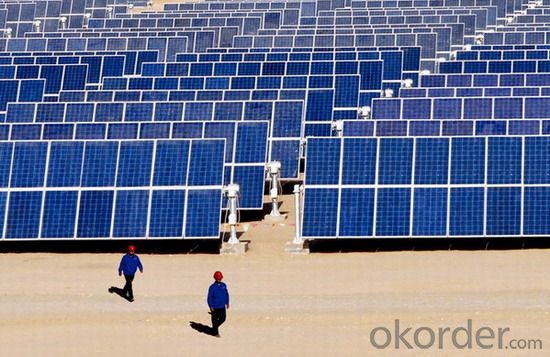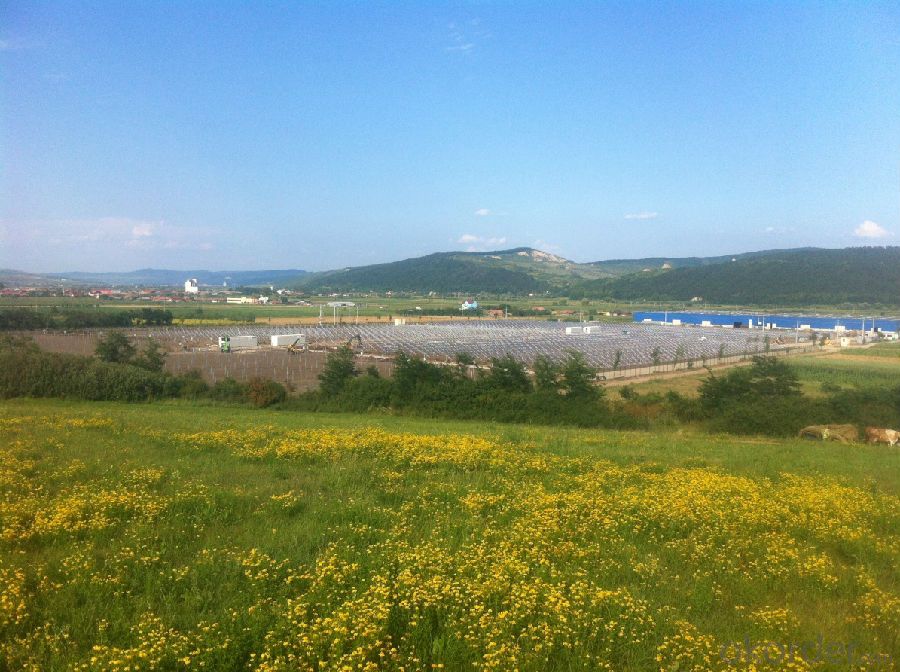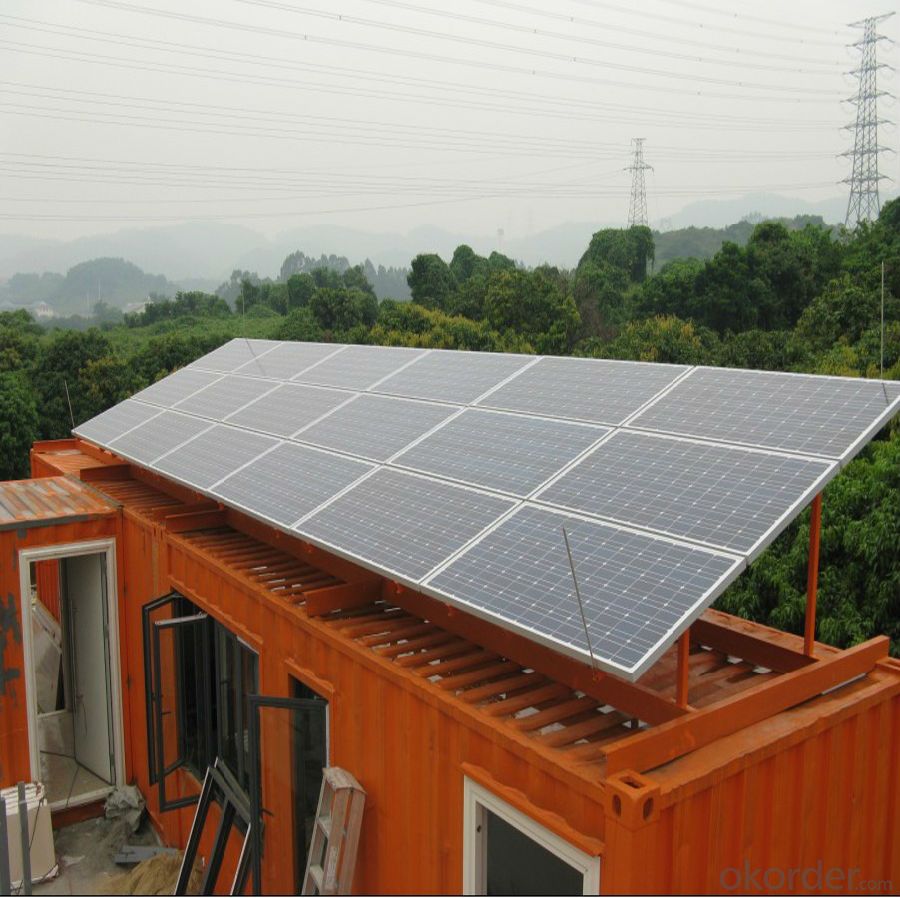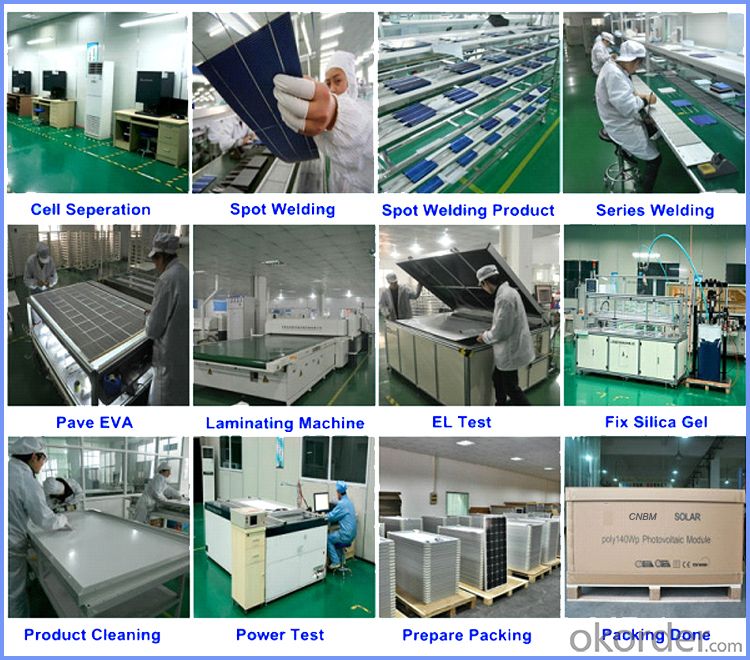CE and TUV Approved High Efficiency 260W Mono Solar Panel
- Loading Port:
- Shanghai
- Payment Terms:
- TT OR LC
- Min Order Qty:
- 10000 watt
- Supply Capability:
- 20000000 watt/month
OKorder Service Pledge
OKorder Financial Service
You Might Also Like
Item specifice
Product Description:
1.Structure of Polycrystalline Silicon Solar Panel
I. High efficiency crystalline silicon solar cell. Even if under the weak light, the solar module can produce maximum power output.
II. Tempered glass (toughened glass): Anti-reflecting coating and high transmission rate glass increase the power output and mechanical strength of solar module.
III. EVA and TPT: Using high quality EVA and TPT to prevent destroying and water.
IV. AI frame: Without screw, rner connection. 6 holes on the frame can be installed easily.
V. Junction box: Multi function junction box with water proof.
VI. Long lifetime: ≥25 years; Less power decrease.
VII. Good performance of preventing from atrocious weather such as wind and hails.
VIII. Resisting moisture and etching effectively, not effected by geology.
IX. The certificate issued by international authority: UL, TUV, IEC, CE.
2.Characteristics
1)Manufactured according to international quality and Environment Management
System (ISO9001, ISO14001)
2)High efficiency crystalline silicon solar cells
3)High transmission Iow iron tempered glass, strong mechanical resistance
4)Anti-ageing EVA and excellent anti-climate back sheet
5)Anodized aluminum frame improves load resistance capabilities for heavy wind loads.
6)Standard waterproof junction box
7)High endurance to different weather
8)Good and friendly package with less transportation and storage space.
3.Warranty
1)10 years limited manufacturing warranty
2)10 years for 90% of warranted minimum power
3)25 years for 80% of warranted minimum power
4.The Pictures of Solar Panels



5. Production Flow

6. Packing Details

7. Use For

- Q:Is it possible to store energy from solar panels for night?
- Yes. okorder /) and informed me of all the incentives I was eligible to receive as well as giving me a break-even analysis, estimated annual savings, and projected return on investment. They are a great resource to begin your solar pursuit. Good Luck!
- Q:Can someone tell me if I can run a air conditioner off solar panel?I have a ET-P65420 20Wp solar panel. What do I need to make it work? I am told I will need a Enphase Energy Microinverter M20. Is that true? I am looking to run a 5000 to 8000btu air conditioner to a max of 0000btu air conditioner. I need to cool a 0x30 space. One time I read, I need total watts of panel to match total watts of air conditioner. Then I read, that I do not and can run more watts then what the panel is depending on the inverter and batteries.Can someone tell me what and how to make this work please? More panes or inverter and batteries?
- You can expect such an air conditioner to use something like 500 - 800 watts of power. The ET-P65420 20Wp solar panel produces at most 20 watts so you will need at least three of them. Since solar cells make DC (Direct Current) electricity, and air conditioners use Alternating Current (AC) electricity, you do need an inverter. The M20 is a 220 volt inverter, and I suspect you are looking at a window air conditioner that will probably use 0 volt power. And the M20 only puts out a maximum of 240 watts so you need one for each of the 3 or more solar panels you will have to use. So the first thing to do is shop for air conditioners, getting the most energy efficient model you can find, paying close attention to the voltage and wattage ratings in the owner's manual or on the UL label on the back. Say it is a 500 watt, 0V unit. You will need three solar panels and three 0 volt model inverters. Also note that the 20 watt rating of the solar panels if when the panel is facing DIRECTLY at the Sun. If you just lay them on the roof, then even if the roof is sloped at a good angle (30 degrees) and facing south, it will only produce the maximum power around noon. 4 hours before noon, unless to go up there and tip them up to face the morning Sun they will probably produce only about half that amount of power. So right there you either need a motorized mount to automatically follow the Sun or twice as many panels. However, if you are going to connect the solar panel(s) into the house power, so that it(they) merely supplement the power company power, then you can use any amount of panels, and the power company will supply whatever extra power you need. That requires a licensed electrician to do. Or if you want to just power the air conditioner directly from the solar panels without any interconnection to the house power, then you need to know a lot more about electricity that you appear to know.
- Q:Ok so i have to solar panels to charge a battery however the panels hooked up in series does charge the battery very slowly because series connections only multiplies the voltage but leaves the current the same. Is there a way i can also hook both of them up in parallel at the same time to multiply the current for faster charge? I know i can do this with 4 panels but i dont want to spend extra. So is there a way to hook up 2 solar panels in series and parallel at the same time? Thanks in advace
- never hook up solar panels in series, you reduce the total power produced, and may hurt them, only voltage out, never voltage in. Don't forget to vote for best answer!
- Q:Ok so i'm writing this research paper on why solar panels are the best way to quot;go greenquot;. I need at least 5-7 reasons why they are good. and a common counterargument that i could defend. I've already come up with incentives and efficiency but i need a few more Please help its very important and worth half my grade
- Actually, solar energy IS a good one. It's something we all need to think about, especially when coal and oil become harder to get. Good luck with your paper!
- Q:Im curious because I read about a boy who invented a 3d solar panel, using a pyramid he designed a solar panel that collects light more efficiently. Now I have a question. Why cant I design a solar panel that takes adventage of convex and concave mirror's and use a surface that collects light and then focus's the suns energy into a beam and take the beam into a chamber where the solar panels are sitting and surround them with mirrors as well, so any light not obsorbed by one particular spot is reflected to another area for reabsorbtion. I know solar panels dont absorb light but perhaps that will allow more light to create the effects it needs.
- I don't know anything about the 3D thing. You cannot get more energy out, than goes in. Energy will only hit the mirrors. With some loss of efficiency they would reflect a focused beam into the chamber, where with some more losses would reflect it to the solar panels. It would be more efficient just to expose all the panels to sunlight.
- Q:Can solar panels be used in areas with high levels of windstorms?
- Yes, solar panels can be used in areas with high levels of windstorms. However, it is important to ensure that the solar panels are properly designed, installed, and secured to withstand the strong winds. Reinforcements and adequate mounting systems can be used to make solar panels more resistant to windstorms.
- Q:I'm re-doing my roof. Is it workable?Can I get a government grant or something to put solar panels on my roof?I know they did something like that for windows.
- I don't think you can get a government grant? At least not just yet... But, you can get a nice Tax break for having installed solar panels on your home or for some their backyard works well. But, again you must be aware that having professionals install these panels can be quite costly. If you don't mind getting your hands a little dirty, tackling this project on your own isn't as hard as you might think! And you will be amazed at how much money you can save from the start. And if you get the family involved all the better! Building affordable solar panels for your home, is no pipe dream...But, you must be willing to do the work yourself! That's usually where most people fall short.
- Q:Can solar panels be used in areas with high levels of salinity or brackish water?
- Yes, solar panels can be used in areas with high levels of salinity or brackish water. While exposure to saltwater can potentially cause corrosion and reduce the efficiency of solar panels over time, there are various measures that can be taken to mitigate these effects. These include selecting corrosion-resistant materials, applying protective coatings, and regular maintenance. Additionally, advancements in solar panel technology have led to the development of more robust and durable panels that can withstand harsh environments, including areas with high salinity or brackish water.
- Q:Can solar panels be used for satellite communication?
- Yes, solar panels can be used for satellite communication. Solar panels are commonly used in satellites to generate electricity from sunlight, which is then used to power various communication systems on board. The panels convert sunlight into electrical energy, which is stored in batteries and used to power the satellite's communication equipment, including transmitters, receivers, and antennas. This allows satellites to communicate with ground stations and other satellites in space, enabling various applications such as weather monitoring, navigation, and telecommunications.
- Q:How do solar panels reduce carbon emissions?
- Solar panels reduce carbon emissions by converting sunlight into electricity without burning fossil fuels. When sunlight hits the solar panels, it triggers a process called the photovoltaic effect, which generates electrical energy. This renewable energy source eliminates the need for traditional power plants that rely on burning fossil fuels, such as coal or natural gas, which release carbon dioxide and other greenhouse gases into the atmosphere. By harnessing solar energy, solar panels enable a cleaner and more sustainable electricity generation, significantly reducing carbon emissions and mitigating the harmful impacts of climate change.
1. Manufacturer Overview |
|
|---|---|
| Location | |
| Year Established | |
| Annual Output Value | |
| Main Markets | |
| Company Certifications | |
2. Manufacturer Certificates |
|
|---|---|
| a) Certification Name | |
| Range | |
| Reference | |
| Validity Period | |
3. Manufacturer Capability |
|
|---|---|
| a)Trade Capacity | |
| Nearest Port | |
| Export Percentage | |
| No.of Employees in Trade Department | |
| Language Spoken: | |
| b)Factory Information | |
| Factory Size: | |
| No. of Production Lines | |
| Contract Manufacturing | |
| Product Price Range | |
Send your message to us
CE and TUV Approved High Efficiency 260W Mono Solar Panel
- Loading Port:
- Shanghai
- Payment Terms:
- TT OR LC
- Min Order Qty:
- 10000 watt
- Supply Capability:
- 20000000 watt/month
OKorder Service Pledge
OKorder Financial Service
Similar products
New products
Hot products
Related keywords




























